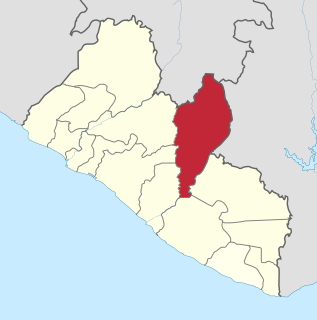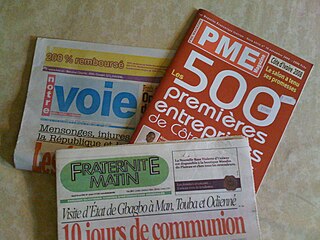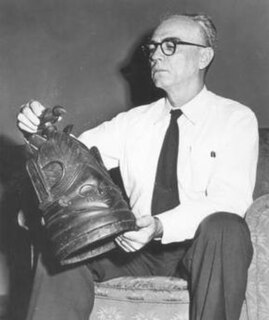
Liberia, officially the Republic of Liberia, is a country on the West African coast. It is bordered by Sierra Leone to its northwest, Guinea to its north, Côte d'Ivoire to its east, and the Atlantic Ocean to its south-southwest. It has a population of around 5 million and covers an area of 111,369 square kilometers (43,000 sq mi). English is the official language, but over 20 indigenous languages are spoken, representing the numerous ethnic groups who make up more than 95% of the population. The country's capital and largest city is Monrovia.

Liberia is a country in West Africa which was founded by free people of color from the United States. The emigration of free people of color, and later former slaves, was funded and organized by the American Colonization Society (ACS). The mortality rate of these settlers was the highest in accurately recorded human history. Of the 4,571 emigrants who arrived in Liberia between 1820 and 1843, only 1,819 survived. In 1847, the ACS encouraged Liberia to declare independence, as the organization could no longer support the colony against territorial incursions by the neighboring British and French. The ACS as well as several northern state governments and local colonization chapters continued to provide money and emigrants as late as the 1870s. The United States declined to act on requests from the ACS to make Liberia an American colony or to establish a formal protectorate over Liberia, but it did exercise a "moral protectorate" over Liberia, intervening when European powers threatened its territory or sovereignty. As a result, eleven signatories established the Republic of Liberia on July 26, 1847, eventually electing the Virginia-born Joseph Jenkins Roberts as the nation's first president.
The Armed Forces of Liberia (AFL) are the armed forces of the Republic of Liberia. Tracing its origins to a militia that was formed by the first black colonists in what is now Liberia, it was founded as the Liberian Frontier Force in 1908, and retitled in 1956. For almost all of its history, the AFL has received considerable materiel and training assistance from the United States. For most of the 1941–89 period, training was largely provided by U.S. advisers, though this assistance has not prevented the same generally low levels of effectiveness common to most of the armed forces in the developing world.

The Kru languages belong to the Niger–Congo language family and are spoken by the Kru people from the southeast of Liberia to the east of Ivory Coast.
The Krahn are an ethnic group of Liberia and Ivory Coast. This group belongs to the Kru language family and its people are sometimes referred to as the Wee, Guéré, Sapo, or Wobe. It is likely that Western contact with the Kru language is the primary reason for the development of these different names.
Prince Yormie Johnson is a Liberian politician and the current Senior Senator from Nimba County. A former rebel leader, Johnson played a prominent role in the First Liberian Civil War, in particular capturing, torturing, mutilating and executing President Samuel Doe, who had himself overthrown and murdered the previous president William R. Tolbert Jr.

The Kru or Kroo are a West African ethnic group who are indigenous to eastern Liberia and migrated and settled along various points of the West African coast, notably Freetown, Sierra Leone, but also the Ivorian and Nigerian coasts. The Kru were famous for their skills in navigating and sailing the Atlantic. Their maritime expertise evolved along the west coast of Africa as they made livings as fishermen and traders. Knowing the in-shore waters of the western coast of Africa, and having nautical experience, they were employed as sailors, navigators and interpreters aboard slave ships, as well as American and British warships used against the slave trade.

The Poro, or Purrah or Purroh, is a men's secret society in Sierra Leone, Liberia, Guinea, and the Ivory Coast, introduced by the Mande people. It is sometimes referred to as a hunting society and only males are admitted to its ranks. The female counterpart of the Poro society is the Sande society.

The First Liberian Civil War was an internal conflict in Liberia from 1989 until 1997. The conflict killed about 250,000 people and eventually led to the involvement of the Economic Community of West African States (ECOWAS) and of the United Nations. The peace did not last long, and in 1999 the Second Liberian Civil War broke out.

Nimba County is a county in northeastern Liberia that shares borders with the Republic of Côte d'Ivoire in the East and the Republic of Guinea in the Northwest. Its capital city is Sanniquellie and its most populous city is Ganta. With the county's area measuring 11,551 square kilometres (4,460 sq mi), Nimba is the largest of Liberia's 15 counties. The county has six statutory districts. As of the 2008 Census, it had a population of 462,026, making it the second most-populous county in Liberia.

The Leopard Society, also known as Ekpe or Mgbe, was the oldest of the Cross River secret societies in West Africa. It was all-male, most likely originating as a warrior society, and assumed importance during the Atlantic slave trade, which was centered in Calabar and dominated by the Efik people by the late 1700s. The trade brought wealth and a range of imported products into Calabar. The Efik, seeking to augment this wealth, also sold memberships in the society to other groups, enabling it to spread widely through the area.
The diverse culture of Ivory Coast, a coastal West African country bordered by Ghana, Liberia, Mali, Burkina Faso, and Guinea, is exemplified by a multitude of ethnic groups, events, festivals, music, and art.
Thomas Gankama-Quiwonkpa, a Gio from Nimba County, was a Commanding General of the Armed Forces of Liberia (AFL) and founder of the National Patriotic Front of Liberia (NPFL).

Ivory Coast is a multilingual country with an estimated 78 languages currently spoken.
Chief Blahsue Vonleh was Paramount Chief of the Doe clan in Nimba County, Liberia from 1920 until his death in 1947.
The Manes or Mani or Manneh were invaders who attacked the western coast of Africa from the east, beginning during the first half of the sixteenth century. Walter Rodney has suggested that "the Mane invaders of Sierra Leone comprised two principal elements — a ruling élite originating in the southern section of the Mande world of the Western Sudan, and numerical forces drawn from the area around Cape Mount"; the first half of the sixteenth century would have taken Mande clans to the Liberian coast "from the region around Beyla and perhaps even from the hinterland of modern Ghana," followed by more incursions during the third quarter of the century, bringing both exploitation of the local peoples and improved military techniques and iron and cloth manufacture. "They also profoundly influenced religious and social patterns, particularly with respect to the secret societies of the area." Yves Person identified the early Mane leaders with the Kamara or Camara clan, "with traditions relating to the sea," from "the Konyan highlands around Beyla." George E. Brooks says they were originally led by "a woman of reputedly elite status from the Mali Empire named Macarico," who "left the Konyan highlands around the mid-1500s and traversed present-day Liberia in a south-southwest direction... Along the way the Mani allied with Sumbas, people speaking Kruan languages."
Mano is an ethnic group of Liberia. The group speaks the Mano language, which belongs to the Mande language family.

Dan art is created by the Dan people of Liberia and the Ivory Coast.

George Way Harley was an American Methodist medical missionary. He spent 35 years in Ganta, Liberia, where he established Ganta Hospital, a school and a church. He was known for his research into the local culture, and received many honors from the Liberian government and from American and British institutions. Major collections of ceremonial masks purchased by Harley in Liberia are held in the Peabody Museum of Archaeology and Ethnology at Harvard University and the Anthropology Department of the College of William & Mary.

Francis Korkpor Sr. is a Liberian lawyer and jurist. He has been the Chief Justice of Liberia since 2013.












